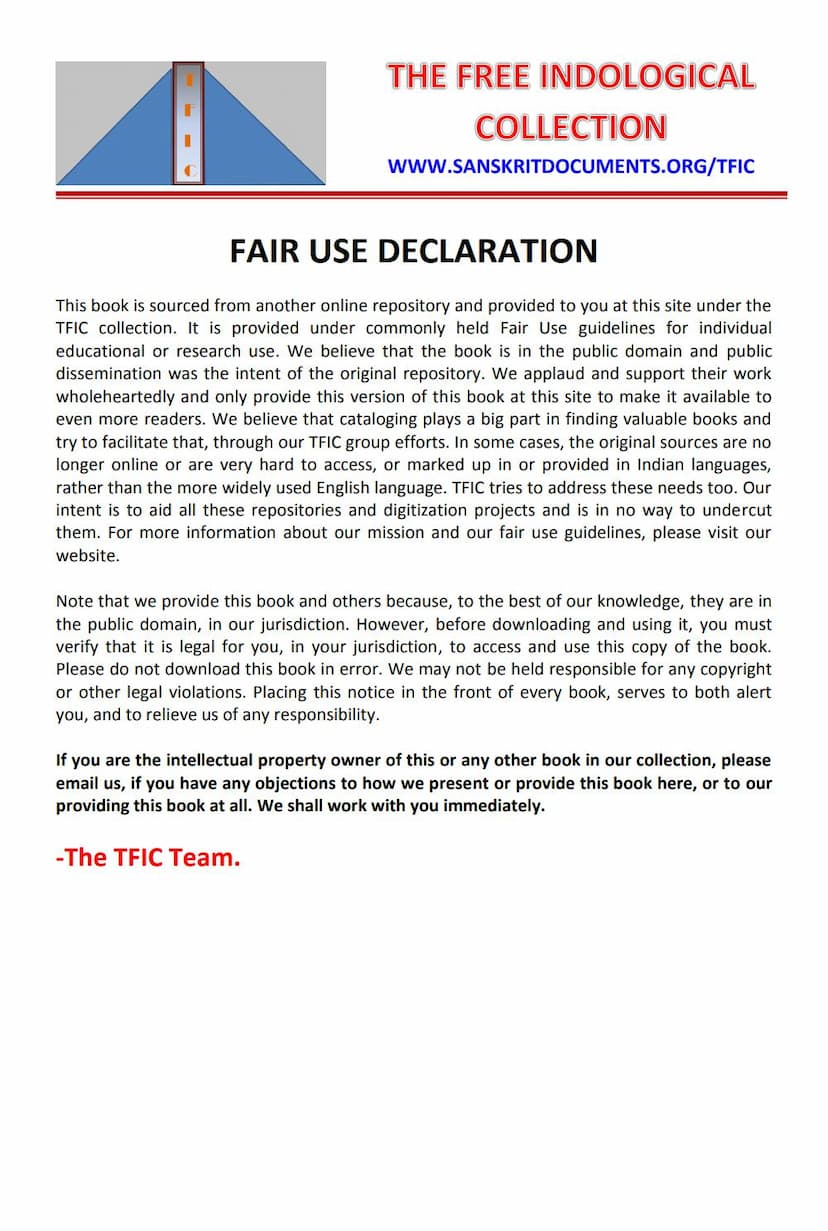Gandavyuha Sutram
Added to library: September 1, 2025

Summary
Here's a comprehensive summary of the Gandavyuha Sutra based on the provided text:
Title: Gandavyuha Sutra Author: Dr. P. L. Vaidya Publisher: Mithila Institute, Darbhanga Series: Buddhist Sanskrit Texts – No. 5 Year: 1960
Overall Scope and Significance:
The Gandavyuha Sutra (GV) is a highly significant Mahayana Buddhist text, considered one of the nine Dharmas or Agamas of Nepalese Buddhism. It is revered worldwide by Mahayana Buddhists. The extant portion presented in this edition is a fraction of the original, which was much more voluminous, as tradition suggests. The work is characterized by its immense scale, hyperbolic descriptions, and vast scope, touching upon the infinite qualities of Buddhas and Bodhisattvas, various samadhis, vimokshas, regions, and kalpas. The phrase "beyond description" accurately captures its essence.
Central Theme and Narrative:
The core narrative of the Gandavyuha Sutra revolves around the spiritual quest of Sudhana (सुधन), the son of a merchant, to learn the path to Buddhahood or Bodhisattvahood. Guided by the Bodhisattva Manjusri (मञ्जुश्री), Sudhana embarks on a journey to visit 110 benevolent friends, known as Kalyanamitras (कल्याणमित्र), who are well-versed in the path. He is also instructed to visit an equal number of places, all situated in Dakshinapatha (दक्षिणापथ), the Deccan region of India.
Sudhana's Journey and Encounters:
The extant portion of the text details Sudhana's encounters with 54 of these Kalyanamitras, starting with Manjusri and ending with Maitreya. These Kalyanamitras represent a diverse array of individuals from various walks of life, including monks, nuns, kings, laymen and laywomen, deities, teachers of arts and crafts, and even women like Gopa (गोपा) and Maya (माया), the wife and mother of Gotama Buddha.
Key Aspects of Sudhana's Learning:
- Learning from Diverse Sources: Sudhana learns from each Kalyanamitra, gaining a unique insight into the vastness of the Bodhisattva path. He discovers that each Kalyanamitra, while enlightened and possessing profound wisdom, has only grasped a fraction of the infinite qualities of a Bodhisattva.
- The Concept of Kalyanamitra: The importance of the Kalyanamitra (spiritual friend or guide) is paramount. These individuals, often possessing profound wisdom and ethical conduct, play a crucial role in guiding Sudhana.
- The Bhadracari Pranidhana: The final stage of Sudhana's learning involves the "Bhadracari Pranidhana" (भद्रचरीप्रणिधान) or "Samantabhadra Charya Pranidhana" (समन्तभद्रचर्याप्रणिधान), which signifies meditation on the conduct prescribed by the Bodhisattva Samantabhadra. This is presented as a crystallization of the course of conduct for achieving Buddhahood.
- Maitreya's Role: At one point, Maitreya, the future Buddha, directs Sudhana back to Manjusri, who then advises him to seek out Samantabhadra. Samantabhadra ultimately teaches Sudhana the "Bhadracari Pranidhana."
Editorial and Textual Details:
- Previous Edition: The volume acknowledges an older printed edition by Professors D. T. Suzuki and H. Idzumi (Kyoto, 1949), based on six manuscripts. This edition, however, lacked proper punctuation, word separation, and verse numbering, making it less accessible.
- The Baroda Manuscript: Dr. P. L. Vaidya's edition is primarily based on the Kyoto edition but crucially incorporates a newly discovered manuscript in Newari script from the Oriental Institute, Baroda. This manuscript, procured from Nepal, provided valuable improvements and filled numerous lacunae, making the text more readable and understandable.
- Textual Challenges: The text itself is noted as being corrupt in places and containing numerous lacunae, even in the Baroda manuscript, indicating it was also copied from an older source.
Stylistic and Linguistic Features:
The language is described as hyperbolic and elaborate, with frequent use of terms like "anabhilapyānabhilāpya" (अनभिलाप्या-नभिलाप्य - indescribable beyond description) and synonyms for vastness like "megha" (cloud), "sagara" (ocean), and "gangā-na-dy-valukā-sama" (गङ्गा-न-दी-वालुका-सम - equal to the sands of the Ganges River), emphasizing the boundless nature of the qualities described. The style is noted as being a "forerunner of the style of Banabhatta" (बाणभट्ट की शैली के पूर्वरूप), suggesting a rich and descriptive Sanskrit prose.
Key Sections and Contents (as per the Table of Contents):
The sutra is structured into sections, with the initial part likely containing:
- Nidana Parivarta (निदानपरिवर्तः): An introductory section describing the Buddha in the Jetavana garden, surrounded by Bodhisattvas, monks, and lay disciples. It sets the stage for the discussion on the unfathomable greatness of the Buddha and the means to attain a fraction of it, which is through the guidance of a Kalyanamitra.
The bulk of the extant text consists of detailed accounts of Sudhana's encounters with the 54 named Kalyanamitras, each described with their:
- Name and Page Numbers: A list of 54 Kalyanamitras with corresponding page numbers in the edition.
- Place of Residence: Various geographical locations mentioned.
- Vocation/Identity: The social role or profession of the Kalyanamitra (e.g., Bhikshu, Shreshthi, Rajah, Devata).
- Special Attainment: The unique realization or spiritual power attained by the Kalyanamitra.
- Results of that Attainment: The beneficial outcomes or manifestations of their attainment.
The text concludes with the recommendation of the "Bhadracari Pranidhana" (भद्रचरी) by Samantabhadra as an essence of the course of conduct.
Conclusion:
The Gandavyuha Sutra, as edited by Dr. P. L. Vaidya, offers a profound exploration of the Mahayana path, emphasizing the importance of diverse spiritual guidance, unwavering devotion to the quest for enlightenment, and the transformative power of compassion and skillful means. Sudhana's journey is a metaphor for the diligent and open-minded pursuit of wisdom from all quarters of life.